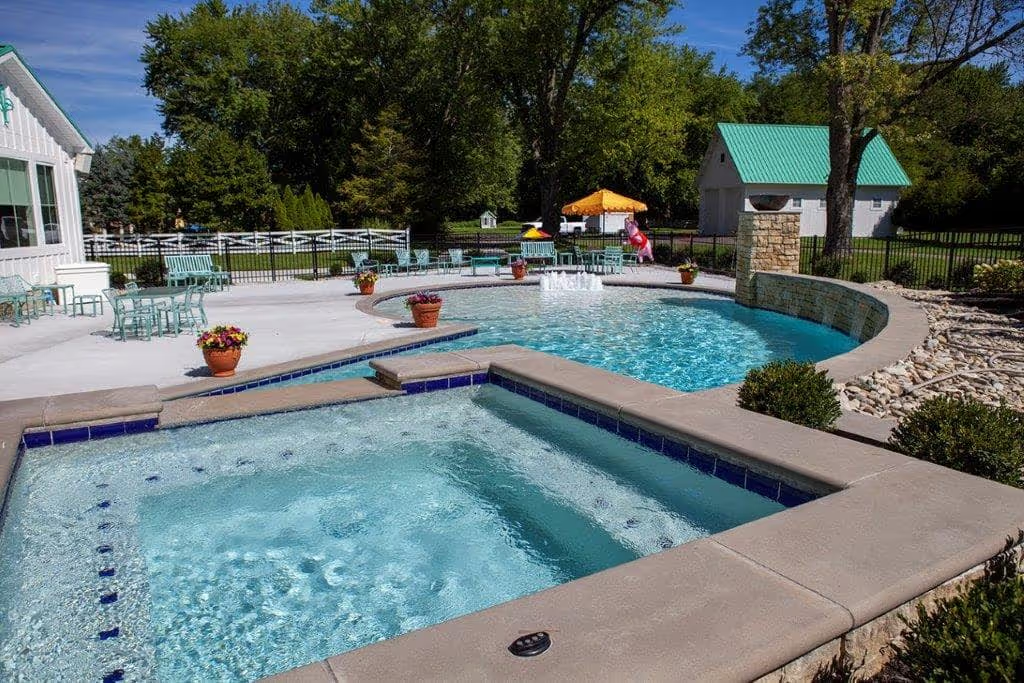- Stone Center
- Blog
The Complete Guide to the Difference Between Porcelain and Ceramic Tiles
19/8/2025
8/19/2025
The Complete Guide to the Difference Between Porcelain and Ceramic Tiles
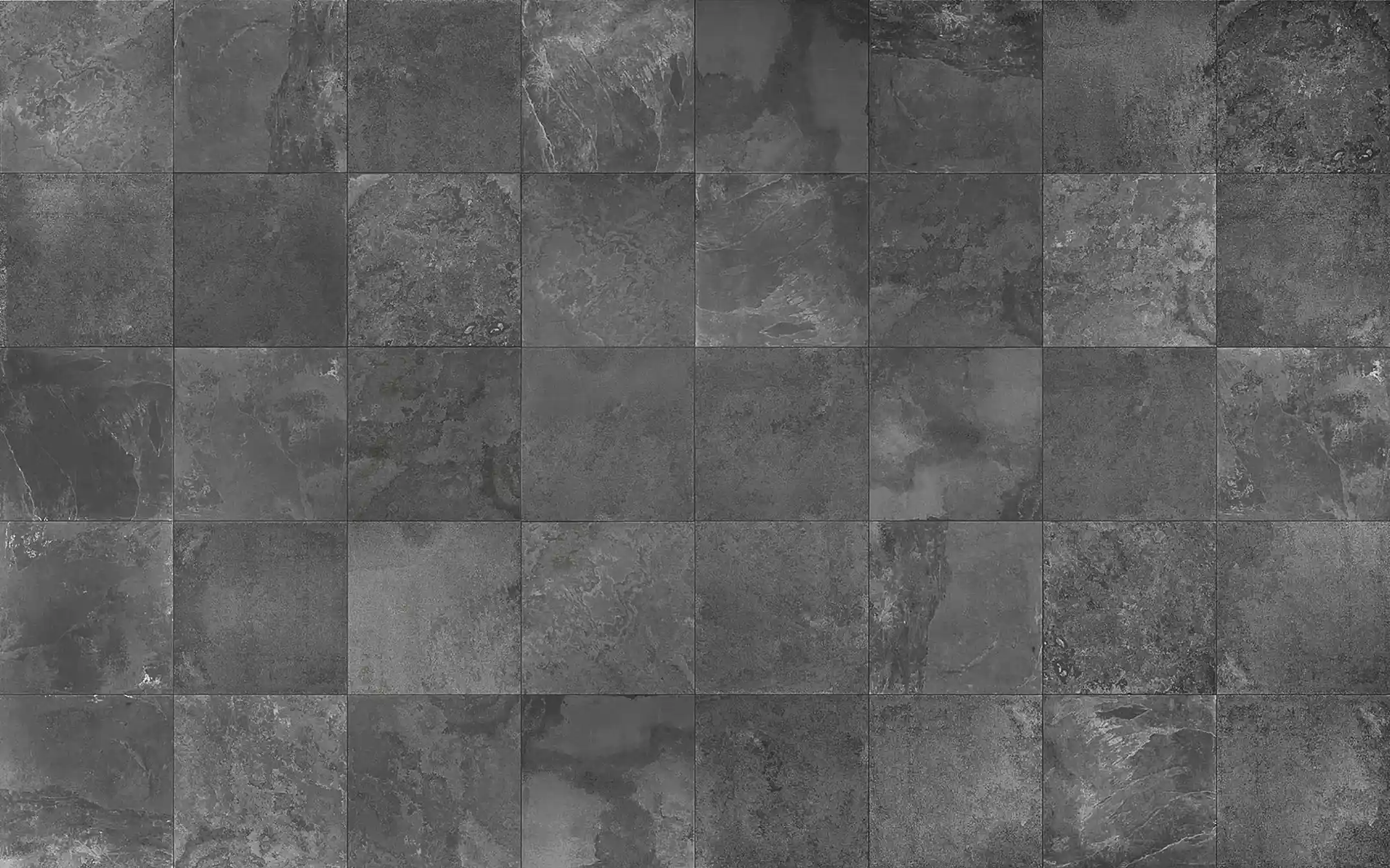
Choosing the right tile can feel like a puzzle. You want something that looks great, lasts long, and fits your lifestyle — but when it comes down to ceramic vs. porcelain, the lines can get blurry. Which one holds up better? Which is more stylish? Which fits your budget? Selecting the wrong one could lead to costly replacements, maintenance headaches, or design disappointments that last for years. A little bit of research can go a long way in helping you make the right decision.
This comprehensive guide breaks down everything you need to know about porcelain tiles versus ceramic options. We'll explore durability, costs, installation requirements, and help you make the smartest choice for your specific needs.
Ceramic and Porcelain Tiles: A Quick Introduction
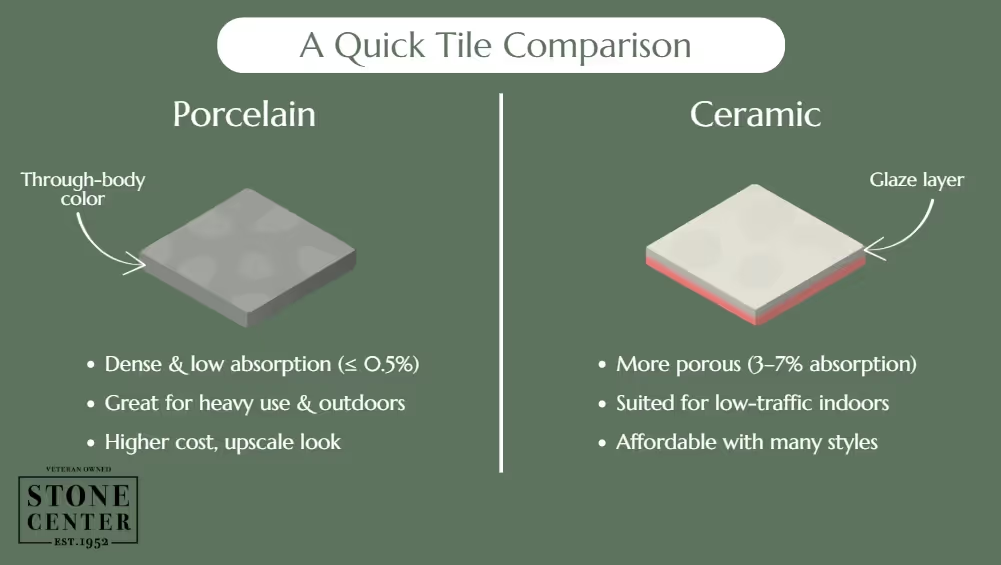
The major difference between porcelain and ceramic tile is the materials and processes used in their production. You should be aware of these differences before making a decision.
What Is Porcelain Tile?
Porcelain tile is made from a mixture of fine-grain, refined clay, and minerals that are pressed into shape and fired at extremely high temperatures, typically between 2,200 and 2,500 degrees Fahrenheit. This creates a dense, hard tile that resists water, stains, and scratches. It can be left unglazed or finished with a smooth, glossy glaze. These porcelain tile advantages make them ideal for high-traffic areas and wet environments.
Pros:
- Highly durable, water-resistant, and stain-resistant
- Available in a wide variety of colors, styles, and finishes
- Relatively easy to clean and maintain
- Can last for many years, even with heavy use
Cons:
- More expensive than other types of tile
- Difficult to install, especially for DIYers
- Hard and slippery, especially when wet
What Is Ceramic Tile?
Ceramic tile is made by combining clay mixture and other natural materials, shaping them, and then firing them at lower temperatures than porcelain tile.
The firing process involves baking the tile in a kiln at temperatures ranging from 1,000 to 1,200 degrees Fahrenheit, which results in a slightly softer material than porcelain tile. Ceramic floor tiles are a popular choice best suited for low-traffic areas, such as bedrooms or guest bathrooms.
Pros:
- Affordable
- Easy to install
- Available in a wide variety of colors, styles, and finishes
- Relatively durable and water-resistant
Cons:
- Less durable than porcelain tile
- More porous than porcelain tile, so it can be more prone to stains
- Can be slippery when wet
Key Differences Between Porcelain and Ceramic Tiles
Not sure which tile is right for your space? Let’s break down the key differences so you can make the best choice with confidence.
Visual Appeal
Porcelain and ceramic tiles both offer a wide range of options when it comes to visual appeal. Porcelain tiles are a popular choice for those looking to achieve a high-end aesthetic in their space, and they come in a variety of colors, sizes, shapes, and finishes.
Ceramic tiles are offered in different colors, patterns, and textures, and they can be glazed or unglazed, with different levels of texture and shine. Ultimately, the visual appeal of porcelain and ceramic tiles will depend on your personal preference and the specific style that you want to achieve.
Better at visual appeal: Porcelain tiles.
Cost
Ceramic tiles typically win the affordability battle, with costs ranging from $1 to $5 per square foot for most residential applications. Their lower manufacturing process costs and simpler production make them a budget-friendly option for homeowners seeking quality flooring.
Porcelain tiles are usually higher in price, typically falling between $3 and $10 per square foot, due to their premium natural materials and energy-intensive manufacturing process. While the initial investment is steeper, their exceptional durability often justifies the extra expense over time.
More budget-friendly: Ceramic tiles.
Durability
Porcelain tiles are known for their exceptional durability thanks to their dense, hard material. They're also more resistant to extreme temperatures and can be used in outdoor areas, while ceramic tiles may crack or chip under these conditions. Porcelain tiles tend to maintain their original appearance for years without fading.
The PEI (Porcelain Enamel Institute) scale rates tiles from 0 to 5 based on their resistance to wear and heavy traffic. Understanding these porcelain tile grades helps you select the right material for your specific application, whether it's residential bathroom flooring or a contemporary commercial space.
More durable: Porcelain tiles.
Water and Heat Resistance

Both ceramic and porcelain tiles offer solid resistance to water and heat, but their performance differs. Porcelain tiles are denser and less porous, with a water absorption rate of 0.5 percent or less, making them highly resistant to moisture, stains, and ideal for wet or outdoor areas.
Ceramic tiles absorb more water, typically between 3 and 7 percent, which makes them more vulnerable to moisture-related damage and heat stress. They’re better suited for low-traffic, dry indoor areas and may require sealing and regular upkeep to stay in top shape.
More water and heat resistant: Porcelain tiles.
Weight
Weight is another consideration. When comparing porcelain vs ceramic tile weight, it's important to note that porcelain tiles are denser and heavier than ceramic tiles. As we discussed above, the high-temperature firing process results in a denser, harder material that is more resistant to water, stains, and scratches than ceramic tiles. It makes them more difficult to handle during installation.
Additionally, the weight of porcelain tiles may require additional support from the subfloor or underlayment. However, this added weight also makes porcelain tiles more durable and suitable for areas with heavy traffic. On the other hand, the lighter weight of ceramic tiles can make them easier to cut and install, but they may not be as durable as porcelain tiles.
Lighter and easier to handle: Ceramic tiles.
Installation and Repairs

When it comes to ceramic vs. porcelain tile flooring installation and repairs, there are some key differences to keep in mind. While both types of tile can be installed using a similar process, porcelain tiles are denser than ceramic tiles, making them more difficult to cut and install. As a result, porcelain tile installation may require specialized tools and expertise, adding to the overall project cost.
In terms of repairs, both porcelain and ceramic tiles can be repaired if damaged. However, porcelain tiles tend to be more expensive to replace due to their higher base cost.
Easier to install: Ceramic tiles.
Care and Cleaning Requirements
Porcelain tiles are easy to clean and maintain, with minimal risk of staining or damage. Many of our customers enjoy that they don't require sealing and can be cleaned with just soap and water or a mild cleaning solution.
Ceramic tiles, while still relatively easy to maintain, may require more frequent sealing and cleaning to maintain their appearance over time. They're also more susceptible to scratches and stains than porcelain tiles.
Easier to maintain: Porcelain tiles.
Lifespan
There's also a difference between porcelain and ceramic floor tile lifespan; porcelain tiles generally have a longer lifespan than ceramic tiles. Impressively, porcelain tiles can last for decades with proper care and maintenance, making them a worthwhile investment for high-traffic areas.
Ceramic tiles, on the other hand, may require more frequent replacement due to their more porous surface, which makes them more susceptible to damage over time. The lifespan of ceramic vs. porcelain tiles can also be impacted by factors such as the installation location, exposure to moisture or extreme temperatures, and level of foot traffic.
Longer lifespan: Porcelain tiles.
Porcelain vs. Ceramic Tiles: Use Cases
Different spaces have different needs, so choose tiles based on moisture, foot traffic, and your style to get the best results. Here's how ceramic and porcelain tiles perform in various applications:
- Outdoor spaces: Porcelain excels in patios and pool areas due to freeze-thaw resistance, while ceramic may chip in harsh climates with high temperatures.
- Entryways: Porcelain handles muddy shoes and salt damage better, though ceramic works in covered, protected areas with lighter use.
- Bathrooms: Porcelain dominates wet areas in terms of superior water resistance, while ceramic works well in powder rooms with minimal moisture exposure and regular maintenance.
- Kitchens: Both perform admirably as flooring options, though porcelain handles spills and heavy use better in busy cooking spaces.
- Living areas: Ceramic offers budget-friendly beauty for moderate-traffic zones, while porcelain withstands heavy family activity better than traditional wood flooring options.
Still unsure? The key is matching material properties to your environmental demands. Porcelain justifies its higher cost in challenging conditions, while ceramic provides excellent value in gentler applications where style and budget-friendly options are priorities.
Deciding Between Porcelain and Ceramic Tiles: Key Factors to Consider

Making the right choice requires evaluating your specific project needs against each material's strengths and limitations. We’ve outlined some essential factors to ensure your investment delivers long-term satisfaction and performance in your space.
Key decision factors include:
- Design preferences: Porcelain often excels at replicating natural stone and wood looks, while ceramic provides endless creative design options and styles.
- Budget constraints: Balance upfront cost against long-term durability and replacement expenses over the tile's lifetime.
- Moisture exposure: High-humidity areas like bathrooms and basements favor porcelain's superior water resistance and porous-resistant qualities.
- Traffic levels: Heavy-use spaces benefit from porcelain's exceptional durability, while ceramic handles light foot traffic beautifully.
- Climate considerations: Outdoor installations in freeze-prone areas require porcelain's high-temperature resistance.
- Maintenance preferences: Busy households appreciate porcelain's low maintenance requirements and don’t require regular sweeping.
Let your circumstances guide your decision over general recommendations. A luxury bathroom renovation justifies porcelain's premium cost, while a guest bedroom refresh might work perfectly with ceramic's budget-friendly and versatile characteristics.
Transform Your Space with the Perfect Tile Choice from Stone Center
In summary, the decision to choose between ceramic vs porcelain tiles depends on a variety of factors, including durability, water resistance, maintenance, cost, and design options. Each type of tile has its unique advantages and can create beautiful and functional spaces when installed properly.
At Stone Center, we know every project deserves materials that match its needs and style. Whether you're drawn to the durability of porcelain or the timeless beauty of natural stone, we’ll help you make the right choice for your situation. As Ohio’s trusted stone supplier since 1952, we're here to bring your vision to life through quality materials and seamless installation. Contact us or visit our website and find the perfect tiles, pavers, or copings for your space.
FAQ
.avif)
Jon, the owner of Stone Center, is a knowledgeable expert in natural stone products, specializing in various types of stone for landscaping and architectural projects. Passionate about promoting the beauty and versatility of natural stone, Jon aims to use these blogs to inspire readers with creative ideas to upgrade their homes.
How much does it cost to get a stone restored?
How much you end up spending to restore stone varies on the type of stone, the technique, and the stone’s current condition. Stone in good condition will cost less to restore, whereas stone that has a lot of wear and tear may require a longer restoration.




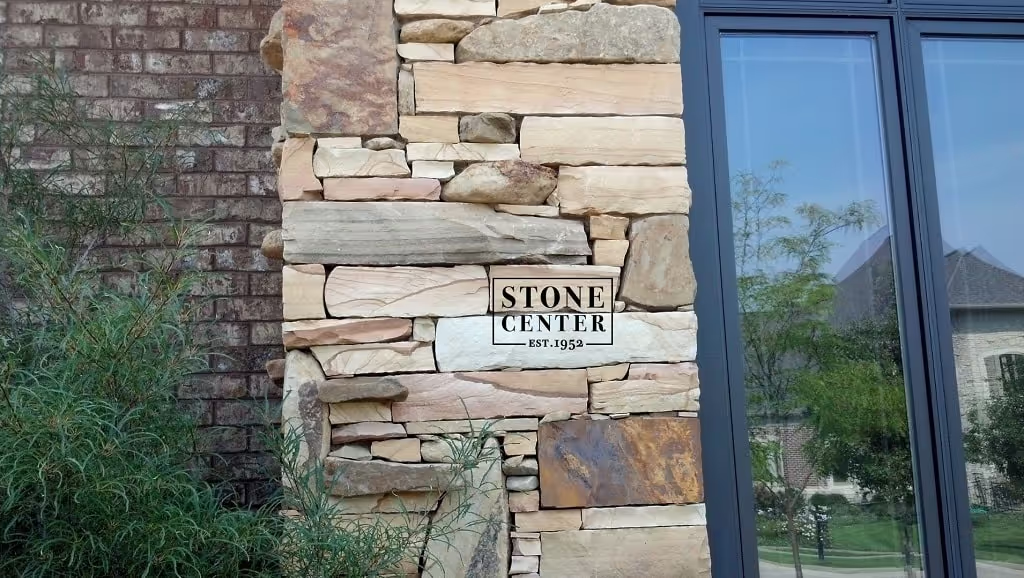
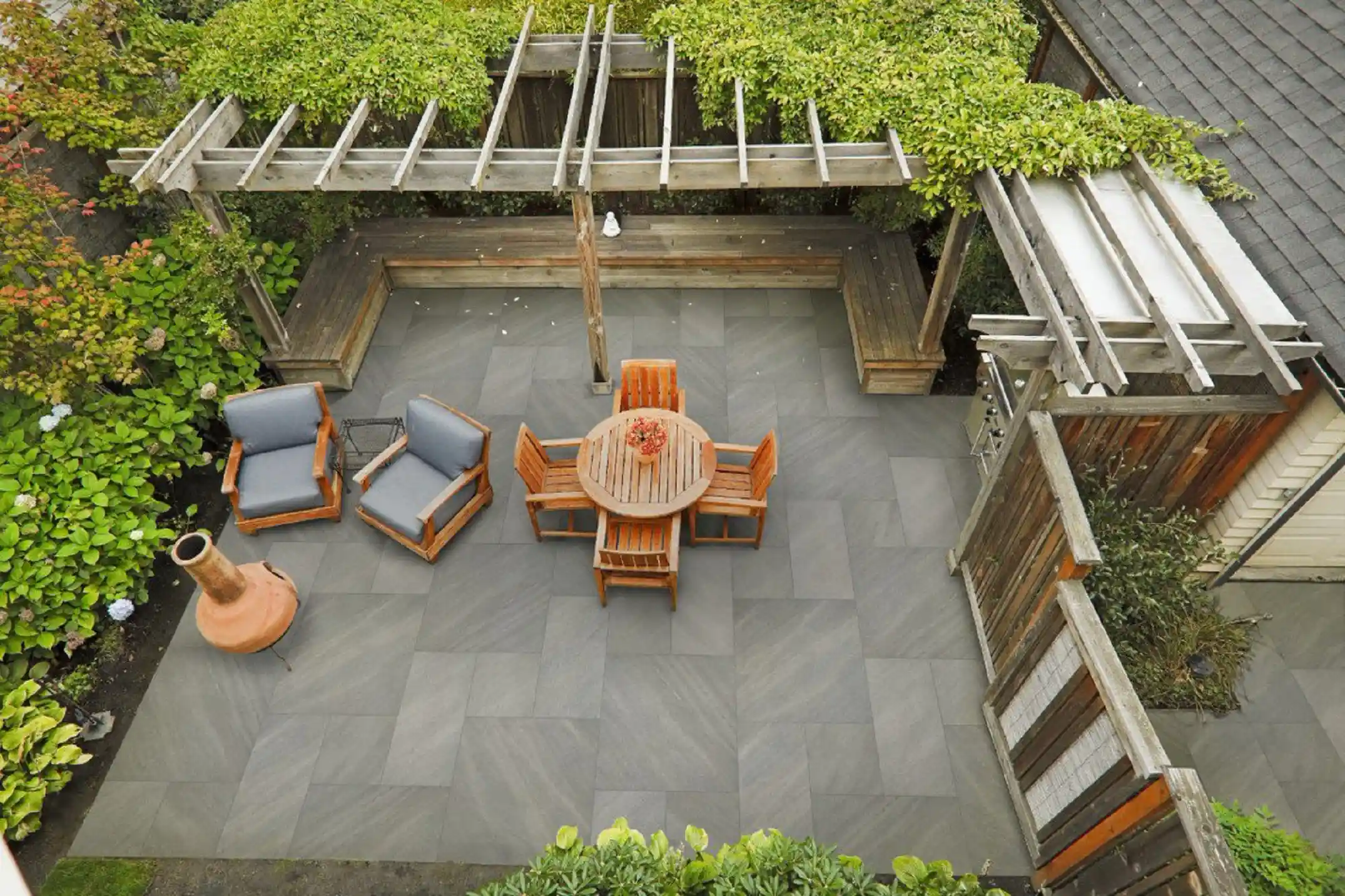
.webp)
.avif)
.avif)
.avif)
.avif)
